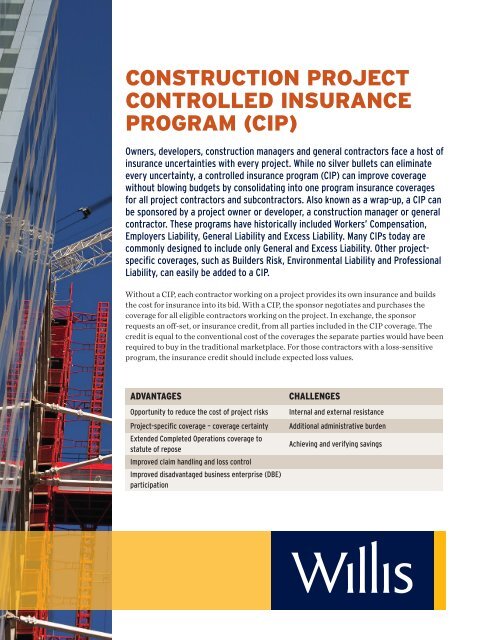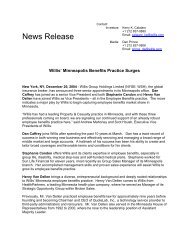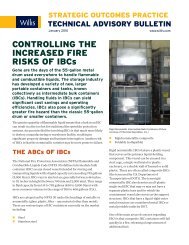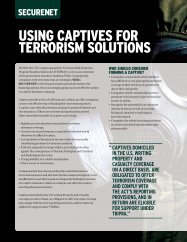construction project controlled insurance program (cip) - Willis
construction project controlled insurance program (cip) - Willis
construction project controlled insurance program (cip) - Willis
Create successful ePaper yourself
Turn your PDF publications into a flip-book with our unique Google optimized e-Paper software.
CONSTRUCTION PROJECT<br />
CONTROLLED INSURANCE<br />
PROGRAM (CIP)<br />
Owners, developers, <strong>construction</strong> managers and general contractors face a host of<br />
<strong>insurance</strong> uncertainties with every <strong>project</strong>. While no silver bullets can eliminate<br />
every uncertainty, a <strong>controlled</strong> <strong>insurance</strong> <strong>program</strong> (CIP) can improve coverage<br />
without blowing budgets by consolidating into one <strong>program</strong> <strong>insurance</strong> coverages<br />
for all <strong>project</strong> contractors and subcontractors. Also known as a wrap-up, a CIP can<br />
be sponsored by a <strong>project</strong> owner or developer, a <strong>construction</strong> manager or general<br />
contractor. These <strong>program</strong>s have historically included Workers’ Compensation,<br />
Employers Liability, General Liability and Excess Liability. Many CIPs today are<br />
commonly designed to include only General and Excess Liability. Other <strong>project</strong>specific<br />
coverages, such as Builders Risk, Environmental Liability and Professional<br />
Liability, can easily be added to a CIP.<br />
Without a CIP, each contractor working on a <strong>project</strong> provides its own <strong>insurance</strong> and builds<br />
the cost for <strong>insurance</strong> into its bid. With a CIP, the sponsor negotiates and purchases the<br />
coverage for all eligible contractors working on the <strong>project</strong>. In exchange, the sponsor<br />
requests an off-set, or <strong>insurance</strong> credit, from all parties included in the CIP coverage. The<br />
credit is equal to the conventional cost of the coverages the separate parties would have been<br />
required to buy in the traditional marketplace. For those contractors with a loss-sensitive<br />
<strong>program</strong>, the <strong>insurance</strong> credit should include expected loss values.<br />
ADVANTAGES<br />
Opportunity to reduce the cost of <strong>project</strong> risks<br />
Project-specific coverage – coverage certainty<br />
Extended Completed Operations coverage to<br />
statute of repose<br />
Improved claim handling and loss control<br />
Improved disadvantaged business enterprise (DBE)<br />
parti<strong>cip</strong>ation<br />
CHALLENGES<br />
Internal and external resistance<br />
Additional administrative burden<br />
Achieving and verifying savings
PROSPECTIVE CIP PROJECTS<br />
MULTIPLE PROJECTS<br />
CIPs can be utilized on a variety of <strong>project</strong>s according to financial, regulatory<br />
and market appetite. A CIP can also be designed for a series of smaller <strong>project</strong>s.<br />
Such a <strong>program</strong> is called a rolling CIP. Rolling CIPs are often sought by owners<br />
with several capital expansion <strong>project</strong>s and by general contractors who want to<br />
include a variety of <strong>project</strong>s.<br />
LARGE PROJECTS<br />
Single <strong>project</strong>s with <strong>construction</strong> values in excess of $200 million may be large<br />
enough to benefit from economies of scale. However, prevailing Workers’<br />
Compensation rates, type of <strong>construction</strong>, <strong>project</strong> duration and payroll content<br />
(i.e., power plants vs. office buildings) also impact the effectiveness or<br />
appropriateness of using a CIP.<br />
MAINTENANCE PROGRAMS<br />
CIPs are not limited to builders. In large facilities (e.g., oil and gas facilities,<br />
petrochemical and power plants), where the operations face many risks<br />
comparable to those at <strong>construction</strong> sites, a CIP can often improve coverage<br />
and generate potential savings.<br />
HOW DO CIPS WORK?<br />
In the standard <strong>insurance</strong> paradigm, contractors purchase <strong>insurance</strong> for all of<br />
their work and spread those costs among the <strong>project</strong>s they work on. Depending<br />
on their size, loss history, states of operation and risk appetite, many of these<br />
contractors purchase guaranteed cost or low deductible <strong>insurance</strong> <strong>program</strong>s.<br />
These approaches tend to be expensive but offer the least volatility and risk.<br />
The contractor’s <strong>insurance</strong> costs typically range from 1% to 3.0% of the hard<br />
<strong>construction</strong> costs of a <strong>project</strong>. The <strong>insurance</strong> costs are loaded into their bid.<br />
CIP sponsors gain coverage and cost advantages by limiting the scope of<br />
coverage to the risks associated with a specific <strong>project</strong> or set of <strong>project</strong>s and by<br />
assuming a high retention or deductible – usually $250,000, $500,000 or<br />
$1,000,000 per occurrence. Programs are typically designed with a peroccurrence<br />
deductible and maximum stop loss. The sponsor will pay a premium<br />
for the fixed costs of <strong>insurance</strong> and the losses arising out of worker injuries and<br />
damages to third parties. Depending on <strong>program</strong> design, the sponsor can gain<br />
significant cash flow by providing collateral (usually a letter of credit or cash)<br />
and only paying losses as they occur.<br />
Setting up a CIP requires work; parties must agree in concept and in detail.<br />
Balancing <strong>program</strong> costs against <strong>insurance</strong> credits is not easy. In some<br />
scenarios, the sponsor may lose out. The guidance of an experienced broker can<br />
help evaluate the cost implications of a CIP.<br />
2
STANDARD CIP COVERAGE LIMITS<br />
WORKERS’ COMPENSATION<br />
Part I<br />
Statutory Benefits<br />
Part II Bodily Injury Each Accident $1,000,000<br />
Disease Policy Limit $1,000,000<br />
Disease Each Employee $1,000,000<br />
GENERAL LIABILITY<br />
Each Occurrence $2,000,000<br />
General Aggregate $4,000,000<br />
Products/Completed Operations Aggregate – Lesser of 10 years or statute of repose $4,000,000<br />
Personal/Advertising Injury $2,000,000<br />
Damages to Premises Rented to Your Limit $100,000–$500,000<br />
Medical Payments – Any one person $10,000<br />
EXCESS LIABILITY<br />
$100M or Higher The amount of CIP excess <strong>insurance</strong> will depend on the size and complexity of the<br />
<strong>project</strong>. Most <strong>project</strong>s should carry at least $100,000,000 in coverage because the limits<br />
are shared with all enrolled contractors. Specialty CIPs such as General Liability only<br />
CIPs on smaller <strong>project</strong>s may feature lower limits.<br />
GENERAL LIABILITY ONLY CIPS<br />
Cost is not always the chief objective in a CIP. In today’s market, many <strong>project</strong> owners and managers face coverage<br />
restrictions, and many sponsors elect to purchase a CIP to improve coverage rather than to achieve savings. Maximum<br />
<strong>program</strong> costs may even exceed conventional costs of <strong>insurance</strong>. There has been a continued increase in the number of<br />
contractors sponsoring CIPs for coverage purposes, as they have begun to recognize that conventional subcontractor<br />
<strong>insurance</strong> is subject to erosion over time and cannot be relied on for protection. When Workers’ Compensation isn’t<br />
economically viable, consider a General Liability only CIP. Through a GL only approach, the sponsor will exercise<br />
control over the scope and extent of coverage, will have first named insured rights vs. additional insured status, and will<br />
not run the risk of coverage erosion that could arise with traditional policies issued annually. General Liability only CIPs<br />
are structured over a primary limit of $1,000,000 to $5,000,000 per occurrence. Retentions begin as low as $25,000 and<br />
there is typically no collateral obligation as long as the retention does not exceed $100,000. These <strong>program</strong>s are usually<br />
Excess & Surplus lines placements, and terms can vary.<br />
3
OWNER VS. CONTRACTOR CONTROLLED<br />
INSURANCE PROGRAMS<br />
Controlled <strong>insurance</strong> <strong>program</strong>s, or wrap-ups, are a method of insuring the <strong>construction</strong> <strong>project</strong> risk of the owner,<br />
contractor, and subcontractors of every tier. While the most successful <strong>program</strong>s inevitably result from a joint effort of<br />
all <strong>project</strong> parti<strong>cip</strong>ants, there are practical considerations that should govern the owner’s choice between an owner<br />
<strong>controlled</strong> <strong>insurance</strong> <strong>program</strong> (OCIP) or contractor <strong>controlled</strong> <strong>insurance</strong> <strong>program</strong> (CCIP).<br />
ISSUE OCIP CONSIDERATION CCIP CONSIDERATION<br />
insurEr sELEction: Insurers will offer<br />
favorable rates, terms, and conditions<br />
to parties/<strong>project</strong>s when losses are<br />
<strong>controlled</strong> and they can expect a fair<br />
return on shareholder equity.<br />
Program controL:<br />
covEragE and Limits: The party that<br />
negotiates with the insurer will have the<br />
most control over coverage and limits.<br />
ExcEss LiabiLity Pricing: Many risk<br />
managers believe that a single excess<br />
limit (e.g., $100,000,000 with annual<br />
reinstatement of limit) may safely be<br />
applied to cover multiple <strong>project</strong>s.<br />
Owner may engage more than one insurer<br />
in competition for the <strong>program</strong> and can<br />
negotiate lines in addition to the OCIP<br />
(e.g., <strong>project</strong> professional, <strong>project</strong><br />
environmental, builders risk). The<br />
burden is on the owner and <strong>project</strong><br />
team to convince underwriters that<br />
losses will be <strong>controlled</strong>.<br />
An owner “owns” the <strong>insurance</strong> <strong>program</strong><br />
throughout the life of coverage and<br />
therefore is not directly impacted by<br />
any change of contractor.<br />
Owner should work in concert with other<br />
<strong>project</strong> members to negotiate a <strong>program</strong><br />
that protects all parties. Limits will be<br />
dedicated to the owner’s <strong>project</strong>(s) and<br />
will not be eroded by the contractor’s<br />
losses on other <strong>project</strong>s. Contractor whose<br />
coverage is broader than the OCIP will<br />
typically include a DIC charge in its bid<br />
so it is important to make sure everything<br />
has been addressed up front.<br />
A policy covering a single <strong>project</strong> will en<br />
tail significantly higher premiums (relative<br />
to <strong>construction</strong> value) than those charged<br />
when a policy covers multiple <strong>project</strong>s. An<br />
owner with multiple <strong>project</strong>s may achieve<br />
economies by purchasing higher limits and<br />
spreading the excess policy over all of<br />
them, with annual reinstatement of limits.<br />
Contractor typically has an established<br />
relationship and track record with one<br />
insurer that provides coverage for all of its<br />
<strong>project</strong>s. A contractor with a proven ability<br />
to control losses may have already<br />
negotiated favorable rates, terms, and<br />
conditions. An owner should scrutinize the<br />
CCIP to determine if this is the case. An<br />
owner may direct an insurer competition<br />
for a CCIP on its <strong>project</strong>.<br />
The contractor “owns” the <strong>program</strong> and<br />
controls all aspects of coverage through<br />
the extended completed operations coverage.<br />
If the owner removes the contractor,<br />
the CCIP goes with the contractor.<br />
Contractor should work in concert with<br />
owner to negotiate a <strong>program</strong> that protects<br />
all parties; however, the contractor<br />
may not be able to enroll parties that<br />
contract directly with the owner. Limits<br />
may apply per <strong>project</strong>, or may be eroded<br />
by losses on other <strong>project</strong>s. Owner should<br />
thoroughly analyze CCIP coverage to<br />
ensure that it fulfills its needs and<br />
contractual <strong>insurance</strong> requirements.<br />
Owner can request they be a Named<br />
Insured on the CCIP.<br />
Contractor will typically buy a single<br />
excess policy to cover all <strong>project</strong>s in its<br />
CCIP, with annual reinstatement of limits.<br />
This provides a cost advantage, but also<br />
brings with it the risk that the limits will<br />
be eroded or even exhausted by losses on<br />
other <strong>project</strong>s. Owner may require a<br />
<strong>project</strong>-specific policy, which is available<br />
in the CIP marketplace.<br />
4
ISSUE OCIP CONSIDERATION CCIP CONSIDERATION<br />
risk/rEwards of ciP: A <strong>controlled</strong><br />
<strong>insurance</strong> <strong>program</strong> is a high-deductible<br />
<strong>program</strong>, and therefore favors the party<br />
that is able to assume and manage risk.<br />
Program cash fLow: Cash-flow benefits<br />
go to the party controlling the funds.<br />
adjustmEnt of contract PricE: Some<br />
or all of the funding for a CIP comes from<br />
a reduced contract price, achieved by<br />
removing contractors’ traditional<br />
<strong>insurance</strong> costs. Whether OCIP or CCIP,<br />
contract price (e.g., GMP) should be<br />
adjusted to remove the effect of avoided<br />
<strong>insurance</strong> costs (“bid deductions”) and<br />
CIP costs.<br />
Program administration: The party<br />
that purchases the <strong>program</strong> is responsible<br />
for providing for administration.<br />
Risk and rewards are assumed by the<br />
owner, who can achieve greatest benefit<br />
by giving parti<strong>cip</strong>ating contractors a<br />
financial stake through safety and other<br />
incentives.<br />
Owner can negotiate terms to spread fixed<br />
and variable expenses up front or over the<br />
life of the <strong>project</strong>. Owner provides<br />
collateral (typically LOC) for deductible<br />
losses. Program remains open until all<br />
claims are settled. The sponsor can work<br />
with the insurer to develop a buy-out<br />
strategy – usually 12 to 18 months beyond<br />
<strong>construction</strong> completion.<br />
Owner should provide for adjustment of<br />
the GMP or lump sum price to reflect<br />
removed <strong>insurance</strong> costs (bid deductions).<br />
The price should be adjusted again at the<br />
end of the <strong>program</strong> to reflect actual<br />
avoided contractor costs. Failure to do so<br />
will result in an unintended costing error<br />
to owner or contractor, depending on<br />
whether the <strong>project</strong> finishes on budget.<br />
Owner should work with contractor to<br />
establish administrative procedures that<br />
complement the contractor’s procedures<br />
in bid award, contract administration and<br />
closeout.<br />
Risk and rewards are assumed by the<br />
contractor, who can achieve greatest<br />
benefit by giving the owner a financial<br />
stake through an open-book shared <strong>program</strong><br />
or a fixed, guaranteed price break.<br />
In some cases contractors will desire to<br />
pass as much of the cost as possilbe<br />
(<strong>program</strong> risk) to the owner in their<br />
pricing. This increases the opportunity<br />
for greater profit.<br />
Contractor will typically stipulate payment<br />
tied to a percentage of progress payments<br />
or a pre-set schedule over the life of the<br />
<strong>project</strong>. Unless negotiated into contract,<br />
owner can close its books with final<br />
contract payment.<br />
Contractor may charge a CCIP to the<br />
owner as a percentage of total contract<br />
value, a specific dollar amount, or on an<br />
open-book basis with shared savings.<br />
Owner should make sure that allowable<br />
charges are understood and monitored,<br />
and that deductible losses are not charged<br />
back to the job in addition to these<br />
amounts.<br />
Contractor will typically have established<br />
procedures for <strong>program</strong> administration.<br />
5
ISSUE OCIP CONSIDERATION CCIP CONSIDERATION<br />
controL of sitE safEty: Should an<br />
accident occur, it is likely the owner’s<br />
name, <strong>project</strong> and circumstances will be<br />
all over the news and in print. Studies have<br />
shown that an owner who takes an active<br />
role in ensuring that safety is managed can<br />
cut expected recordable accidents in half,<br />
with benefits that reach well beyond<br />
deductible losses in an <strong>insurance</strong> <strong>program</strong>.<br />
A team approach to safety should be<br />
employed whether an OCIP, CCIP or<br />
traditional <strong>insurance</strong> <strong>program</strong> is instituted.<br />
The Contractor is in the best position to<br />
manage safety on the <strong>project</strong> site. The<br />
owner should however take an active<br />
interest in <strong>construction</strong> safety. For<br />
instance:<br />
n Require site-specific safety <strong>program</strong><br />
from GC/ CM<br />
n Establish minimum safety requirements<br />
that also mirror what the insurer will<br />
require<br />
n Set safety as criteria in contractor<br />
selection<br />
n Maintain proactive involvement during<br />
<strong>construction</strong><br />
n Require contract language to include<br />
enforcement of safety <strong>program</strong> with<br />
consequences<br />
n Implement safety incentives<br />
n Include a line item for <strong>project</strong> safety<br />
in the <strong>construction</strong> budget<br />
Regardless of a CCIP approach, the<br />
owner should still take an active interest in<br />
<strong>construction</strong> safety. For instance:<br />
n Require site-specific safety <strong>program</strong><br />
from GC/CM<br />
n Set safety as criteria in contractor<br />
selection<br />
n Maintain proactive involvement during<br />
<strong>construction</strong><br />
n Require contract language to include<br />
enforcement of safety <strong>program</strong> with<br />
consequences<br />
n Implement safety incentives<br />
managing ciP cLaims: Regardless of<br />
who purchases the <strong>insurance</strong> <strong>program</strong>, the<br />
handling of claims can affect the finances<br />
and reputations of all parties involved,<br />
including the owner, contractors, and<br />
injured third parties and workers.<br />
cLaims ExcEEding PoLicy Limits: The<br />
only liability intrinsically created by a<br />
<strong>controlled</strong> <strong>insurance</strong> <strong>program</strong> is that of<br />
procuring <strong>insurance</strong> coverage as required<br />
by contract, and paying premiums and<br />
deductible losses.<br />
continuity of covEragE: Coverage that<br />
lapses can create severe problems for the<br />
owner and parti<strong>cip</strong>ating contractors.<br />
Owner manages claims to the benefit of<br />
injured parties and all <strong>project</strong> parti<strong>cip</strong>ants<br />
and is in the best position to manage<br />
public relations. Owner should include<br />
contractors in these discussions. They are<br />
concerned about their companies’<br />
reputations, the well-being of employees,<br />
and experience modification factor (EMR),<br />
which may affect pricing of their companyspecific<br />
<strong>insurance</strong> and are affected by<br />
workers compensation losses.<br />
Liability for claims exceeding policy limits<br />
remains with the negligent party. Owner<br />
should not specify that coverage for work<br />
on an OCIP be “excluded” on contractors’<br />
corporate <strong>program</strong>s, as this removes that<br />
source of recovery and may imply a<br />
limitation of liability.<br />
The owner is responsible for paying all<br />
premiums and deductible losses and<br />
thereby controls the continuity of the<br />
<strong>insurance</strong> <strong>program</strong>. Contractors should<br />
be provided ample notification in event of<br />
cancellation, nonrenewal or material change.<br />
Contractor manages claims, and may do<br />
so in a manner to minimize ultimate<br />
payout at the expense of other issues<br />
such as public relations. Contractor may<br />
not feel comfortable including other<br />
contractors in the discussion on open<br />
claims. Owner should be comfortable<br />
with the contractor’s approach to claim<br />
settlement prior to agreeing to a CCIP.<br />
Liability for claims exceeding policy limits<br />
remains with the negligent party.<br />
The contractor is responsible for paying<br />
premiums and deductible losses. Owner<br />
may require ample notification in the<br />
event of cancellation, nonrenewal, or<br />
material change.<br />
6
ISSUE OCIP CONSIDERATION CCIP CONSIDERATION<br />
covEragE of muLtiPLE contracts: An<br />
owner with an extremely large <strong>project</strong> that<br />
will be conducted in phases, or multiple<br />
<strong>project</strong>s, will likely engage the services<br />
of different general contractors.<br />
An OCIP may be written to cover multiple<br />
phases or <strong>project</strong>s with different general<br />
contractors. An owner with such <strong>project</strong>s<br />
planned should benefit more from an OCIP.<br />
It is unlikely that all contractors with<br />
whom the owner contracts will have a<br />
CCIP or that the quality of coverage will<br />
be uniform under these separate CCIPs<br />
from <strong>project</strong> to <strong>project</strong>.<br />
CIP INSURERS<br />
As of 2012, the standard primary CIP market consists of:<br />
n<br />
n<br />
n<br />
n<br />
ACE<br />
Chartis<br />
ARCH<br />
The Hartford<br />
n<br />
n<br />
n<br />
n<br />
Liberty Mutual<br />
Old Republic<br />
Travelers<br />
Zurich<br />
While all of these markets can be effective doing major <strong>project</strong>s, each has its own particular appetites.<br />
n<br />
n<br />
n<br />
n<br />
n<br />
Several markets favor contractor-<strong>controlled</strong> <strong>insurance</strong> <strong>program</strong>s (CCIPs). These include Zurich and Travelers.<br />
Zurich will play a role on owner-driven <strong>project</strong>s, but prefers to look at contractor-<strong>controlled</strong> <strong>program</strong>s, and<br />
Travelers will only support its own insureds when it underwrites CCIPs. Chartis has recently announced that<br />
they will be much more aggressive in underwriting CCIP <strong>program</strong>s as well. Note these markets do routinely look<br />
at their underwriting appetites and will consider an owner-<strong>controlled</strong> <strong>insurance</strong> <strong>program</strong> (OCIP) that fits their<br />
underwriting criteria.<br />
Hartford re-entered the CIP market through a limited distribution network of select brokers.<br />
Old Republic initially offered only guaranteed cost <strong>program</strong>s but transitioned to offering large deductible <strong>program</strong>s<br />
in 2008.<br />
Back in 2009, Arch created an underwriting unit that was to focus primarily on OCIPs. Before that time, Arch was a<br />
heavy player in the CCIP market.<br />
ACE and Liberty Mutual continue to have a broad appetite for OCIP and CCIP business.<br />
WILLIS: THE LEADER<br />
<strong>Willis</strong> is one of the largest <strong>construction</strong> brokers and is a leading producer in the CIP marketplace. <strong>Willis</strong>’ dedicated<br />
National CIP Practice team of 35 professionals delivers industry-leading service in:<br />
n<br />
n<br />
n<br />
Program design, marketing and placement<br />
Account management<br />
Quality control and training<br />
n<br />
n<br />
Data management capabilities through our<br />
WrapTrac Center<br />
Technology solutions<br />
7
WILLIS CIP EXPERIENCE INCLUDES MORE THAN 500<br />
CURRENT OR COMPLETED PROJECTS<br />
n<br />
n<br />
n<br />
n<br />
n<br />
Sports and Entertainment<br />
(stadiums/arenas)<br />
Health Care<br />
Office and Technology (high-rise/campus)<br />
Transportation (airports and rail) and<br />
Infrastructure<br />
Residential (single family/multifamily/condo)<br />
n<br />
n<br />
n<br />
n<br />
Gaming and Hospitality<br />
Education Facilities<br />
Energy (pipelines/power plants)<br />
Manufacturing and Petrochemical<br />
(new/maintenance)<br />
WRAPTRAC CENTER – CENTRALIZED DATA MANAGEMENT<br />
n<br />
n<br />
n<br />
10,000 contracts managed<br />
7,000 contractors<br />
Contractor <strong>insurance</strong> credit and payroll<br />
benchmarking<br />
n<br />
n<br />
Maximizing efficiencies and accuracy<br />
Higher quality of work<br />
This conduit of experience and our One Flag approach ensures that <strong>Willis</strong> clients have easy access<br />
to comprehensive expertise and resources, including superior market strength.<br />
CONTACT<br />
David DeLaRue, ARM, AIC, CPCU<br />
+ 1 972 715 6216<br />
david.delarue@willis.com<br />
Lori Robinett, CIC<br />
+1 972 715 6249<br />
lori.robinett@willis.com<br />
8











